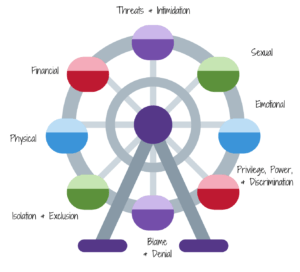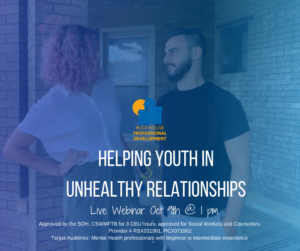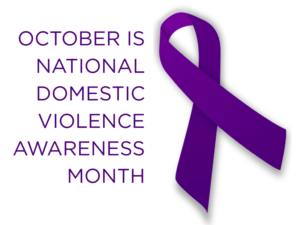Domestic violence continues to be a common issue for youth in Ohio.
As youth become more technologically savvy, so do their abusers and the form abuse takes. Rather than abuse being isolated to their home – many experiences these tactics on social media, their cell phones, in their cars and more. Technology has made it easier than ever to stalk, control, monitor, and harm youth.
What do abusive relationships look like
Abusers have always used dynamics of power and control with their partners. Tactics, such as isolation or intimidation, create a power imbalance between the partners. Tactics used to create the power imbalance vary by abuser, as not every abuser relies on the same tactics, but every abusive relationship falls into the power and control pattern.
At Huckleberry House, we created a worksheet that describes the Power and Control wheel in terms that youth understand. The worksheet compares relationships to a Ferris wheel – imagine you are riding a Ferris wheel with your partner. They are enjoying the ride, but you are not. Your partner will use whatever tactics they need to keep you on the ride. Technology has not changed these tactics but made them easier to use. Even after a partner leaves the ride, technology allows the abuser to follow them onto other amusement rides, engaging in the same tactics. Preventing the partner from truly leaving the relationship – or leaving the abuse. 
Technology is a status symbol
In the last five years, I have become behind the curve of new technology and owning the “best new thing”. But for youth, this is an important status symbol. Which is why as professionals, we need to understand the technology our clients are using.
- We need to understand how an abuser can install an app on someone’s phone without their knowledge.
- Ways to prevent hackers from using webcams to monitor.
- Access voter registration databases to find their new address.
- View images on social media to access their location and monitor how they spend their time.
- How small tracking or GPS devices can be.
- That nanny cams are not always visible or “in the teddy bear”.
- Smart home devices, such as thermostats, locks, and lights can be controlled from the abuser’s home and lack protections to prevent hacking.
- Mistakes can be posted, shared, and online forever.
- Log in information can be stored on profiles, as well as devices.
- Abusers can make unlimited number of profiles.
- Abusers with access to a survivor’s friends online can gather info through their connection.
It is not our responsibility to outsmart abusers – but we can help prepare our youth for the realty that it’s not just their job they have to leave anymore – they might lose their social media accounts, connections to family members states away, or even give up their twitter followers. All to protect themselves.
Real Life Experience
I recently helped a client who was being threatened by their ex. The threats were not face to face, but through various social media accounts. It went beyond threatening their personal safety to interfering with their income, which primarily came from their YouTube, Facebook, and Instagram posts.
All of which was public and allowed their ex to threaten their followers, post threats on public forums, and make others scared to be in contact with my client. This resulted in my client making the difficult decision – they shut down their YouTube page, changed their phone number, moved, and started a new job. This stopped the threats for a while, but eventually my client created a new social media page. And eventually their abuser found it and started again.
Moving forward
Leaving abusers has always been intertwined with loss. But now youth are being asked to be different from their friends and family. To give up sharing pictures of their vacations, children, and following their high school friends as they build their own lives.
I find it’s helpful to validate and acknowledge the youth’s loss. Even though it might feel small to us, it is a status symbol in the lives of youth. Youth don’t understand reasons for someone not having SnapChat. Youth struggle to understand the true vulnerability that social media invites into our lives.
How to make technology safer
- Know what technology your client uses
- Change devices (when possible)
- Research apps and install any apps they do not use or are flagged as “risky” by experts
- Trust your instincts
- Clear their history, data, cache on all devices, apps, and browsers
- Do not save log in information
- Disconnect smart home devices
- Change passwords and usernames (as well as safety questions or pin codes)
- Make sure no cloud accounts are being shared to the abuser
- Do not allow apps (especially your camera app) to log location data
- Cover up web cams, microphones, and other recording software
- Unplug cameras or microphones when not in use
- Look into your states’ address confidentiality program
- Lock down your settings
- Do not use your legal name or a well-known nickname on social media
- Do not comment on other’s posts
- Change your email address
- Use internet protection – make sure they offer mobile protection for phones and tablets
- Find out how to turn off or uninstall GPS devices from your car
- Unplug baby monitors when not in use
- Look at your online friends list and block / restrict / remove any mutual friends shared with abuser
- Update settings to block any unknown accounts from adding you as a friend or sending you a message
- Contact your cell phone carrier to set your phone as ‘Private’ for outgoing calls
- Consult an expert
Whether a partner uses technology currently or isn’t technology savvy, it is important to plan and educate every youth in an unhealthy relationship. Taking steps to protect themselves early, helps keep them safe when they leave the relationship.
Resources for you
Intimate Partner Violence Safety Plan
Unhealthy Relationships Workbook
Join Us

Helping Youth in Unhealthy Relationships
Friday, Oct 9th, 2020 @ 1 pm
What You’ll Learn:
- Identify unhealthy youth relationships
- Improve techniques to respond to unhealthy youth relationships
- Prevent youth relationships from becoming unhealthy or violent
Program Description
This training focuses on the various forms and types of unhealthy romantic relationships. Participants will learn the differences between healthy and unhealthy relationships for youth, as well as the difference between teen dating violence, intimate partner violence, domestic violence, and mutual violence. Gain needed skills to identify, assess, and safety plan with clients in unhealthy relationships. Enhance your ability to engage with clients through youth specific case studies, ethical discussion making prompts, and practice using youth informed language. Participants will also gain an overview of the various systems presented to youth in unhealthy relationships and how this impacts mental health work.
Clock Hours: 3 CEU Hours
Approved by the SOH, CSWMFTB for 3 CEU Hours; approved for Social Workers and Counselors. Provider # RSX031901, RCX071902
Target Audience: Mental Health professionals with beginner to intermediate experience
Cost: $30



